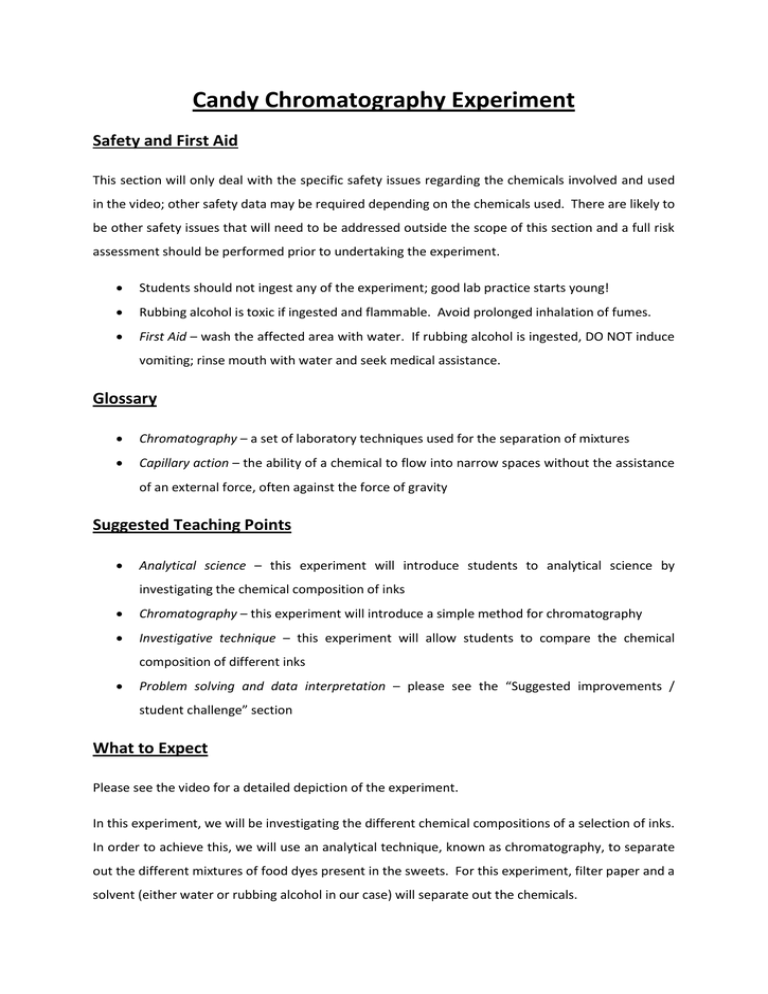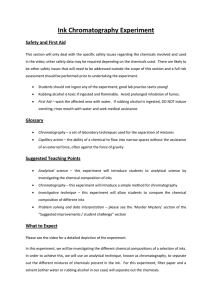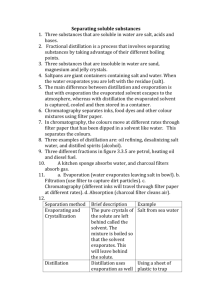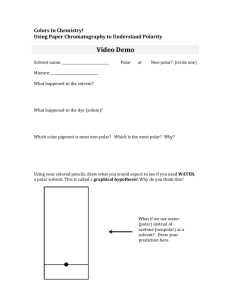Candy Chromatography Experiment Safety and First Aid
advertisement

Candy Chromatography Experiment Safety and First Aid This section will only deal with the specific safety issues regarding the chemicals involved and used in the video; other safety data may be required depending on the chemicals used. There are likely to be other safety issues that will need to be addressed outside the scope of this section and a full risk assessment should be performed prior to undertaking the experiment. Students should not ingest any of the experiment; good lab practice starts young! Rubbing alcohol is toxic if ingested and flammable. Avoid prolonged inhalation of fumes. First Aid – wash the affected area with water. If rubbing alcohol is ingested, DO NOT induce vomiting; rinse mouth with water and seek medical assistance. Glossary Chromatography – a set of laboratory techniques used for the separation of mixtures Capillary action – the ability of a chemical to flow into narrow spaces without the assistance of an external force, often against the force of gravity Suggested Teaching Points Analytical science – this experiment will introduce students to analytical science by investigating the chemical composition of inks Chromatography – this experiment will introduce a simple method for chromatography Investigative technique – this experiment will allow students to compare the chemical composition of different inks Problem solving and data interpretation – please see the “Suggested improvements / student challenge” section What to Expect Please see the video for a detailed depiction of the experiment. In this experiment, we will be investigating the different chemical compositions of a selection of inks. In order to achieve this, we will use an analytical technique, known as chromatography, to separate out the different mixtures of food dyes present in the sweets. For this experiment, filter paper and a solvent (either water or rubbing alcohol in our case) will separate out the chemicals. To begin with, a sample of the mixture of food colouring used to cover the sweets is obtained by standing the sweet in a droplet of water. This solution of dye is then placed on the bottom of the filter paper and the solvent allowed to be drawn through via capillary action. As the solvent passes the food colouring, any chemicals that dissolve in the solvent will be carried along as the solvent continue up the filter paper. The distance that each separate food colour moves is dependent on how well it dissolves in the solvent and how strongly it binds to the paper fibres. For a food dye that dissolves will in the solvent and does not bind to the filter paper, it will travel further than a chemical that dissolves well but binds strongly. Once the solvent has reached the top of the filter paper, each food colouring will have left behind a characteristic patter showing the mixture of chemicals that were contained in the sweet. Equipment and Chemicals Water Pencil Filter paper Selection of sweets Scissors Water with a pinch of salt dissolved Containers Rubbing alcohol A plastic bag or cling film Pipettes Supplementary Instructions The baseline must be drawn in pencil. If you use a pen, the ink may move and mix with the inks you are investigating. It is essential that the level of solvent is below the pencil baseline and does come into contact with any of the inks you are investigating. To increase the rate at which the solvent travels through the filter paper, cover the top of the container to make an airtight seal. Try and handle the filter paper as little as possible while wet to prevent tearing. Suggested Questions for Students What use could chromatography have in chemical industry? – chromatography is an essential technique utilised by a wide of analytical professions. For example, synthetic chemists use chromatography to purify chemicals before they are allowed into use (e.g. pharmaceutical drugs). Other uses include forensic science and checking the purity of water. Why do food colourings have different coloured chemicals in them? – often, a number of different coloured dyes are needed to provide the exact colour required. How do you know if the red food dye from Skittles is the same as the red food dye from M&M’s? – if the red food dye colour has travelled the same distance up the filter paper, then it is likely that they are the same (within the accuracy of this experiment). If the two different red spots have travelled different distances, this would indicate that it is not the same red food dye. Suggested Improvements / Student Challenge Use other solvents – students could investigate how other solvents separate out the different chemicals present in ink. Ethyl acetate and acetone (found in different types of nail varnish remover; see the ingredients label for which) could be used as well as vegetable oil; remember to complete a new risk assessment for this! Comparison of brands – students can investigate whether red sweets from different brands use the same mixture of food dyes to achieve the colour. Clean up and Waste Disposal The specific waste disposal protocols for this experiment will depend upon the choice of liquids used. Spillages can be cleaned with water and paper towel. Filter paper and sweets can be disposed of in the bin.





